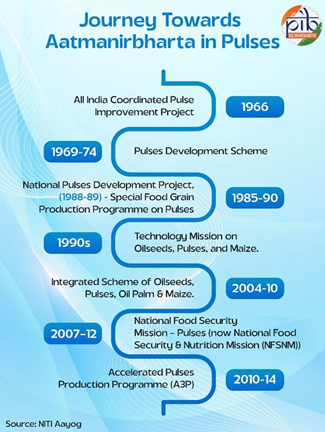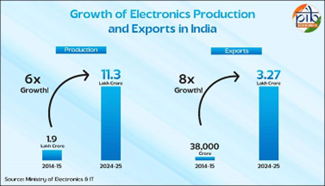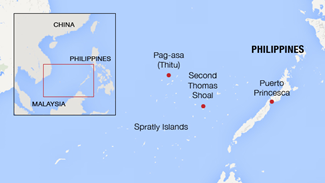Polity
Sugamya Bharat App:
-
- The Department of Empowerment of Persons with Disabilities launched the revamped ‘Sugamya Bharat App’ at Purple Fest, Goa, as a one-stop digital accessibility hub for persons with disabilities.
- The app features accessibility mapping, community ratings for public spaces, a consolidated directory of schemes, job and education listings, a grievance redressal module, screen reader compatibility, voice navigation, and multi-language support.
- The app is designed with a user- and accessibility-first approach, supports assistive technologies on both Android and iOS, and aims to empower disabled persons to access information, demand accessibility, and participate in community-led improvements.
- Developed with support from SBI Foundation and partners, it builds on the earlier Accessible India Campaign, evolving into a comprehensive, mobile-based ecosystem for digital inclusion of persons with disabilities.
(PIB)
Art and Culture
Recent excavations in T.N.’s Tenkasi reveal presence of Iron Age culture:
-
- The first season of excavations carried out by the Tamil Nadu State Department of Archaeology (TNSDA) at Thirumalapuram in Tenkasi district has brought to light the presence of Iron Age culture close to the Western Ghats in Tamil Nadu.
- The site could date back to the early to mid-third millennium BCE, like Adichanallur and Sivagalai.
- TNSDA archaeologists dug 37 trenches and unearthed several artefacts, including a rectangular stone slab chamber with urn burials and urns, a first-of-its-kind discovery in Tamil Nadu. The chamber, made of 35 stone slabs, was filled with cobblestones up to a depth of 1.5 metres.
- The excavations also yielded a rich collection of ceramics found in graves and among grave goods. These included whitepainted black-and-red ware, red ware, redslipped ware, black-polished ware, and coarse red ware.
(TH)
Economy
Mission for Aatmanirbharta in Pulses:
-
- The Mission for Aatmanirbharta in Pulses (Dalhan Aatmanirbharta Mission) was launched in October 2025 with an outlay of ₹11,440 crore, aiming to make India self-reliant in pulses by December 2027 and fully meet future demand through domestic production.
- The Mission will be implemented from 2025–26 to 2030–31 and aims to boost domestic pulses production, reduce import dependence, and strengthen nutritional security.
- Production of pulses rose from 192.6 lakh tonnes in 2013–14 to 38 lakh tonnes in 2024–25, but India still imported 47.38 lakh tonnes in 2023–24, underlining the need for further improvement.
- The objective is to expand the area under pulses cultivation by 35 lakh hectares, promote intercropping, crop diversification, and disseminate high-yielding, pest-resistant, and climate-resilient pulse varieties, alongside distributing 126 lakh quintals of certified seeds and 88 lakh free seed kits to farmers.
- The Mission incorporates the SATHI portal for end-to-end seed traceability and plans rolling five-year state seed production plans to ensure quality and supply chain transparency.
- Assured procurement of Tur (Arhar), Urad, and Masoor pulses under PM-AASHA will be provided for four years in participating states to ensure farmers receive fair prices and income security.
- 1,000 processing and packaging units will be established with up to ₹25 lakh subsidy per unit, to reduce post-harvest losses, add value, and generate rural employment.
- By 2030–31, the Mission targets 310 lakh hectares under pulses, 350 lakh tonnes production, and improved yields of 1,130 kg/ha.
- Recommended strategies include integrating pulses into welfare programs (PDS, Mid-Day Meals), using a cluster-based approach for cultivation and seed hubs, mechanization, efficient irrigation, use of bio-fertilizers, and deployment of early warning and monitoring systems through the SATHI Portal.
- These combined efforts aim to ensure nutritional security, rural prosperity, reduced import dependence, increased farmer incomes, and climate-resilient agricultural growth.

(PIB)
India’s Electronics Leap:
-
- India’s electronics manufacturing sector has grown sixfold in the last decade, creating 25 lakh jobs and aiming for a $500 billion ecosystem by 2030–31.
- Key government schemes—PLI, SPECS, and ECMS—are driving rapid growth, with PLI alone attracting over $4 billion FDI since 2020–21 and ECMS expected to generate ₹10.34 lakh crore in production and 1.4 lakh direct jobs over six years.
- Electronics—including mobiles, automotive, medical, and consumer goods—are now essential drivers of India’s economy, with strong policy support, export expansion, and global supply chain integration.
- National Policy on Electronics aims to position India as a global hub for Electronics System Design and Manufacturing, targeting $400 billion in revenue by 2025.
- Electronics underpin critical Indian sectors, from consumer goods to automotive and medical, powering national innovation and economic competitiveness.

(PIB)
India’s Power Sector:
-
- Central Electricity Authority (CEA) celebrated its 52nd Foundation Day on 11 October 2025, focusing on the roadmap to develop 100 GW nuclear capacity by 2047 for energy reliability and climate commitments.
- CEA released a “Road Map for Achieving 100 GW of Nuclear Capacity by 2047”, a “Master Plan for Evacuation of Power from Hydroelectric Plants in the Brahmaputra Basin” and launched the Electrical Accident Data Monitoring System (EADMS) portal for nationwide electrical safety.
- The event featured policy discussions, technical sessions on nuclear and renewable energy integration, and recognized CEA’s key role in modernization, planning, and technological innovation for India’s sustainable and resilient electricity supply.
- Industry and government speakers emphasized nuclear power’s importance for deep decarbonization, energy security, and India’s Net Zero by 2070 goals.
(PIB)
Geography & Environment
Thitu Island:
-
- Context: China and the Philippines trade blame over boat collision in disputed sea.
- Also known as Pag-asa Island, is the second largest naturally occurring island in the Spratly Islands, South China Sea, and the largest Philippine-occupied Island in the region.
- It is administered by the Philippines as part of Kalayaan municipality, Palawan, and hosts a permanent civilian settlement, military presence, and infrastructure including an airstrip, harbour, school, and lighthouse.
- The island is strategically located about 24–27 km from China’s Subi Reef, a militarized artificial island, making it a focal point in the South China Sea dispute.
- Claimed by China, Taiwan, and Vietnam in addition to the Philippines, it is central to regional tensions over sovereignty, maritime rights, and resource exploration.
- Recent developments include runway concreting, a new sheltered port, and civilian infrastructure upgrades, reinforcing Philippine presence amid increasing Chinese patrols and pressure.

(TH)
Schemes and Initiatives in the News
PM Dhan Dhaanya Krishi Yojana and Mission for Aatmanirbharta in Pulses:
-
- PM Modi launched two major schemes—the PM Dhan Dhaanya Krishi Yojana (₹24,000 crore) and Mission for Aatmanirbharta in Pulses (₹11,440 crore)—with a combined outlay exceeding ₹35,000 crore to empower farmers, boost agricultural productivity, and enhance nutritional security.
- The PM Dhan Dhaanya Krishi Yojana focuses on 100 selected districts, aims to increase agricultural output, crop diversification, irrigation, storage, and credit, by converging 36 government schemes in an integrated approach.
- The Mission for Aatmanirbharta in Pulses targets expanding the area under cultivation by 35 lakh hectares, especially for pulses like tur, urad, and masoor, and will directly benefit two crore farmers by ensuring procurement and value chain support.
- Modi highlighted record growth in foodgrain, fruit, milk, and honey production, the doubling of insurance and market access (FPOs, cooperative societies), and the government’s structural reforms—including for women farmers and rural technology—aiming for self-reliance and export-driven growth in agriculture.
- The program also saw the inauguration/dedication of projects worth over ₹5,450 crore in agriculture, animal husbandry, fisheries, and food processing, and the laying of foundation stones for further projects worth around ₹815 crore.
(PIB)
PRACTICE MCQ’S
Q1. Consider the following statements about the revamped Sugamya Bharat App:
1. It was launched as part of the Accessible India Campaign to improve accessibility for persons with disabilities and the elderly.
2. The app allows users to map and rate public places for accessibility and register grievances related to inaccessible infrastructure.
3. It provides a consolidated directory of government schemes, scholarships, and employment opportunities for persons with disabilities.
4. The app was developed solely by the Department of Empowerment of Persons with Disabilities.
Which of the statements given above are correct?
a) 1, 2 and 3 only
b) 1, 2 and 4 only
c) 2, 3 and 4 only
d) 1, 2, 3 and 4
Answer: A
Explanation:
Statements 1, 2, and 3 are correct:
-
- The Sugamya Bharat App was launched under the Accessible India Campaign (Sugamya Bharat Abhiyan) by the Department of Empowerment of Persons with Disabilities.
- It features accessibility mapping, user ratings, and a grievance redressal module for inaccessible infrastructure, plus a consolidated directory of schemes and employment opportunities.
Statement 4 is incorrect:
-
- The app was developed with external support from partners such as the SBI Foundation, NAB Delhi, ISTEM, and Mission Accessibility, not solely by the department
Q2. Which of the following statements about the recent Tenkasi excavations is NOT correct?
a) The site at Thirumalapuram may date back to the early to mid-third millennium BCE.
b) Archaeologists discovered a rectangular stone slab chamber with urn burials.
c) The excavation team dug several trenches and found various types of ceramics, including black-polished ware.
d) The excavations were carried out by Archaeological Survey of India.
Answer: D
Explanation:
Statements A, B, and C are correct based on the findings.
Statement D is incorrect because the excavations were carried out by the Tamil Nadu State Department of Archaeology (TNSDA).
Q3. Consider the following statements regarding the Mission for Aatmanirbharta in Pulses (Dalhan Aatmanirbharta Mission):
1. The Mission was launched in October 2025 with an aim to achieve self-reliance in pulses by December 2027.
2. It includes assured procurement of Tur, Urad, and Masoor under PM-AASHA.
3. The Mission plans to expand the area under pulses cultivation and distribute certified seeds to farmers.
4. By 2030–31, the Mission targets 350 lakh tonnes of pulse production.
Which of the statements given above are correct?
a) 1, 2 and 3 only
b) 1, 2 and 4 only
c) 2, 3 and 4 only
d) 1, 2, 3 and 4
Answer: D
Explanation:
All four statements are correct. The Dalhan Aatmanirbharta Mission, launched in October 2025, has an outlay of ₹11,440 crore to make India self-reliant in pulses by December 2027. It runs till 2030–31, covering expansion of 35 lakh ha, seed distribution and traceability via the SATHI portal, assured procurement under PM-AASHA, and aims for 350 lakh tonnes production from 310 lakh ha with 1,130 kg/ha yield.
Q4. Which of the following statements about recent developments in India’s power sector in October 2025 is NOT correct?
a) The Central Electricity Authority aims to achieve 100 GW of nuclear capacity by 2047.
b) The CEA released a Master Plan for Evacuation of Power from Hydroelectric Plants in the Brahmaputra Basin.
c) The EADMS portal was launched for nationwide electrical safety data monitoring.
d) The target for nuclear capacity under the new roadmap is 50 GW by 2035.
Answer: D
Explanation:
Statements A, B, and C are correct. The incorrect statement is D because the roadmap aims for 100 GW nuclear capacity by 2047, not 50 GW by 2035.
Q5. Consider the following statements regarding Thitu Island:
1. This Island is the largest naturally occurring island in the Spratly group.
2. The island lies close to China’s Subi Reef.
3. It is claimed solely by the Philippines with no overlapping claims from other nations.
Which of the above given statements are correct?
a) 1 and 2 only
b) 2 and 3 only
c) 1 and 3 only
d) 1, 2 and 3
Answer: A
Explanation:
Statements 1 and 2 are correct: Thitu (Pag-asa) is the largest Philippine-held island in the Spratly Islands, administered under Kalayaan municipality, Palawan, and lies about 24–27 km from China’s Subi Reef.
Statement 3 is incorrect: The island is disputed, with overlapping claims from China, Taiwan, and Vietnam in addition to the Philippines.
Q6. Consider the following statements:
1. The PM Dhan Dhaanya Krishi Yojana seeks to converge multiple existing government schemes in 100 selected districts to enhance agricultural productivity, crop diversification, and irrigation facilities.
2. The Mission for Aatmanirbharta in Pulses aims to expand pulse cultivation by 35 lakh hectares, focusing mainly on crops such as tur, urad, and masoor, and will directly benefit around two crore farmers.
Which of the statements given above is/are correct?
a) 1 only
b) 2 only
c) Both 1 and 2
d) Neither 1 nor 2
Answer: C
Explanation:
-
- The PM Dhan Dhaanya Krishi Yojana indeed integrates 36 existing government schemes across 100 selected districts to boost productivity, diversification, irrigation, storage, and credit access.
- The Mission for Aatmanirbharta in Pulses aims to expand pulse cultivation by 35 lakh hectares, focusing on tur, urad, and masoor, and ensures direct benefits to about two crore farmers through procurement and value chain support.

